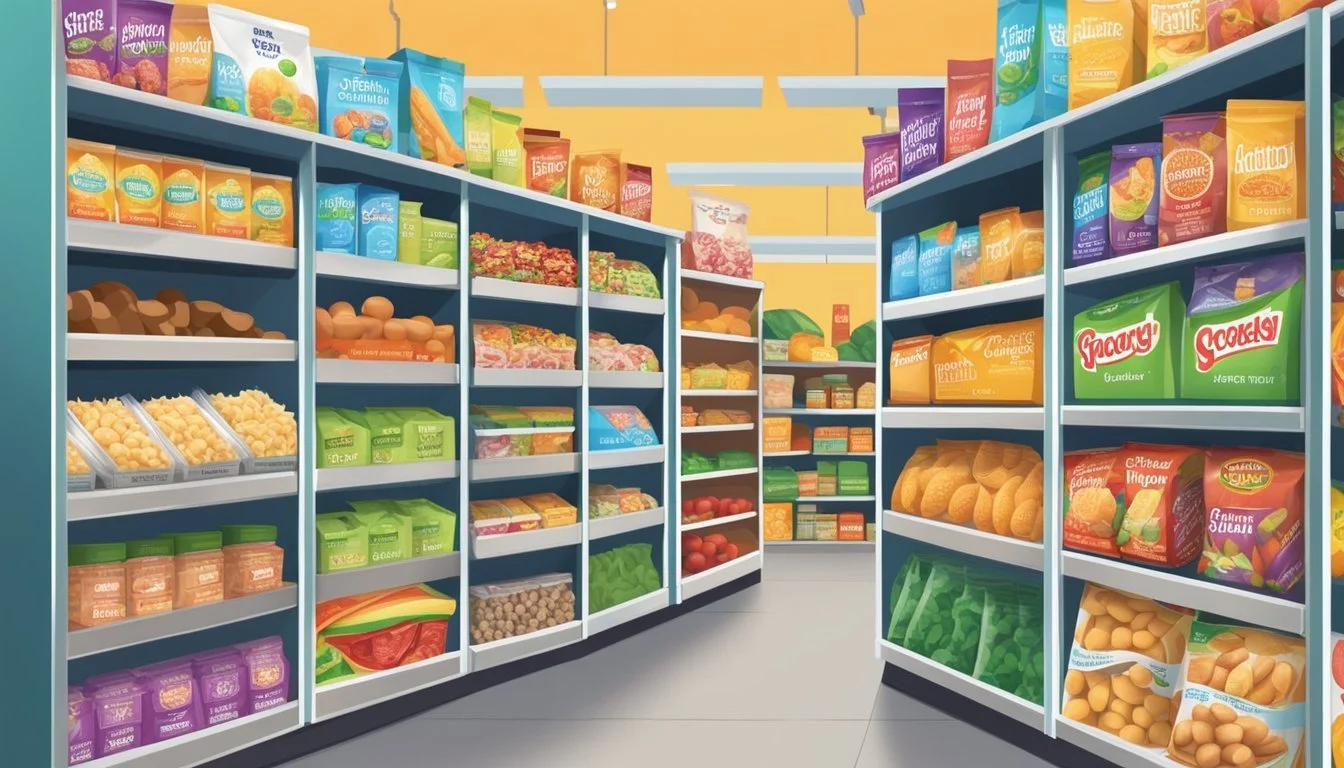Snack Paradise: Unveiling the Best Grocery Stores for Irresistible Treats
Snack lovers know the importance of finding the right grocery store to satisfy their cravings. With countless options lining the shelves, choosing a go-to spot for tasty treats can be overwhelming. The best grocery stores for snacks offer a wide variety of options, from classic favorites to innovative new flavors, while balancing taste with nutritional value.
Popular chains like Target and Walmart stock an extensive selection of snacks, including crowd-pleasers such as Rold Gold pretzels and Honey Maid graham crackers. These stores often carry both name-brand items and their own private label alternatives, providing options at various price points. Health-conscious shoppers can find nutrient-dense choices like protein bars, nuts, and veggie chips alongside traditional snacks.
Specialty grocers and natural food stores cater to those seeking unique or health-focused snack options. These shops may carry a curated selection of organic, gluten-free, or plant-based snacks that are harder to find in mainstream supermarkets. Regardless of dietary preferences, the ideal snack destination offers quality products, competitive prices, and a diverse array of flavors to suit every palate.
Understanding Snacks and Nutritional Value
Snacks play a crucial role in daily nutrition, offering a balance of macronutrients and micronutrients essential for energy and health. Choosing the right snacks can support overall wellness and maintain steady blood sugar levels throughout the day.
Macronutrient Breakdown of Common Snacks
Protein, carbohydrates, and fats are the three main macronutrients found in snacks. Protein-rich options include Greek yogurt, cheese, and roasted edamame. These snacks provide about 15 grams of protein per serving.
Carbohydrates are abundant in granola bars and popcorn. They offer quick energy but vary in nutritional value. Whole grain options provide more fiber and nutrients.
Fats are present in nuts, seeds, and certain dairy products. Almonds and cashews contain healthy monounsaturated fats, essential for hormone production and nutrient absorption.
Snack Protein (g) Carbs (g) Fat (g) Greek Yogurt 15 7 3 Almonds (1 oz) 6 6 14 Popcorn (3 cups) 3 18 1
The Role of Fiber and Healthy Fats in Snacking
Fiber is a crucial component of healthy snacking. It promotes satiety, aids digestion, and helps maintain stable blood sugar levels. Vegetable sticks, freeze-dried fruits, and whole grain crackers are excellent sources of dietary fiber.
Healthy fats, such as those found in avocados, nuts, and seeds, contribute to brain health and help absorb fat-soluble vitamins. These fats also slow digestion, providing a feeling of fullness for longer periods.
Seaweed snacks offer a unique combination of fiber and healthy fats. They are low in calories and rich in minerals, making them a nutritious choice for snacking.
Balancing Sugars and Carbohydrates for Energy
Balancing sugar intake is essential for maintaining stable energy levels. Natural sugars found in fruits provide quick energy along with vitamins and minerals. Artificial sugars in processed snacks can lead to energy crashes.
Complex carbohydrates, like those in whole grain snacks, release energy slowly. This gradual release helps maintain steady blood sugar levels throughout the day.
Pairing carbohydrates with protein or healthy fats can further stabilize blood sugar. For example, combining an apple with peanut butter creates a balanced snack that provides sustained energy.
Some snacks, like Babybel cheese, offer protein without added sugars. This makes them an excellent choice for those monitoring their carbohydrate intake.
Choosing Healthy Snacks
Selecting nutritious snacks at the grocery store can support overall health and weight management goals. The right choices provide energy, satisfy cravings, and deliver important nutrients.
Navigating the Snack Aisle for Healthy Options
Look for snacks with simple, recognizable ingredients. Avoid items with long lists of additives or artificial ingredients. Choose organic options when possible to reduce exposure to pesticides.
Focus on nutrient-dense whole foods like fruits, vegetables, nuts, and seeds. These provide fiber, vitamins, minerals, and antioxidants. Aim for snacks that combine protein, healthy fats, and complex carbs for lasting energy.
Read nutrition labels carefully. Check serving sizes and aim for snacks with less than 200 calories per serving. Look for options low in added sugars and sodium but high in fiber and protein.
Identifying Whole Food Snacks
Whole food snacks are minimally processed and retain their natural nutrients. Fresh fruits and vegetables make excellent choices. Apples, berries, carrots, and celery are portable and nutritious.
Nuts and seeds offer healthy fats and protein. Almonds, walnuts, pumpkin seeds, and sunflower seeds are great options. Look for unsalted or lightly salted varieties.
Legume-based snacks like roasted chickpeas or edamame provide protein and fiber. Whole grain crackers paired with hummus or guacamole offer complex carbs and healthy fats.
Selecting Snacks for Weight Loss Goals
Choose low-calorie, high-volume snacks to feel full on fewer calories. Fresh vegetables with salsa or Greek yogurt dip are filling and nutritious.
Opt for high-protein snacks to increase satiety. Hard-boiled eggs, Greek yogurt, and cottage cheese are good choices. Protein bars with minimal added sugars can be convenient options.
Air-popped popcorn is a whole grain snack that's low in calories but high in fiber. Avoid varieties with added butter or excessive salt.
Select portion-controlled snack packs to prevent overeating. Single-serve packages of nuts, seeds, or dried fruits can help with portion control.
Popular Snack Categories
Grocery stores offer a wide variety of snack options catering to different tastes and dietary needs. From nutrient-dense nuts to protein-packed options, there's something for everyone looking for a quick and satisfying bite.
Nuts and Seeds: Packed with Nutrients
Nuts and seeds are powerhouse snacks, offering a combination of healthy fats, protein, and essential minerals. Walnuts stand out for their omega-3 content, supporting heart and brain health. Almonds provide vitamin E and magnesium, while pumpkin seeds are rich in zinc.
These snacks are versatile and easy to incorporate into daily routines. Many stores offer both raw and roasted varieties, as well as flavored options for those seeking extra zest.
Portion control is key with nuts due to their calorie density. Pre-portioned packs are available for convenient, mindful snacking.
Dried Fruits and Natural Sweetness
Dried fruits offer a concentrated source of natural sweetness and fiber. Popular options include raisins, apricots, and cranberries. These snacks provide quick energy and are often rich in antioxidants.
Many stores now stock exotic dried fruits like goji berries or dried mango slices, expanding flavor profiles. Some brands offer unsweetened varieties for those monitoring sugar intake.
Dried fruits pair well with nuts, creating a balanced snack mix. They're also great for adding to yogurt or oatmeal for a nutrient boost.
Protein-Rich Snacks for Satiety
Protein snacks help maintain fullness and support muscle health. Beef jerky is a popular choice, offering a savory option with minimal preparation. Look for low-sodium varieties to keep salt intake in check.
Daisy cottage cheese provides a creamy protein source, rich in casein for slow-release amino acids. It's versatile and can be paired with both sweet and savory toppings.
Greek yogurt, hard-boiled eggs, and protein bars are other readily available options in most grocery stores. These snacks can help bridge the gap between meals and support active lifestyles.
Fiber-Rich Snacks for Gut Health
Fiber-rich snacks support digestive health and promote feelings of fullness. Roasted chickpeas have gained popularity as a crunchy, high-fiber option. They come in various flavors and provide both fiber and protein.
Healthy chips made from vegetables or whole grains offer a satisfying crunch with added nutritional benefits. Look for options made from kale, sweet potatoes, or quinoa.
Popcorn, when air-popped or lightly seasoned, is another excellent fiber-rich choice. It's low in calories and provides volume, making it a satisfying snack option.
Fiber-rich snack bars containing ingredients like oats, chia seeds, and dried fruits are also widely available. These "healthy bites" can provide a quick fiber boost on the go.
The Rise of Plant-Based and Alternative Snacks
Plant-based and alternative snacks have surged in popularity, offering diverse options for health-conscious consumers. These innovative products cater to various dietary needs while providing satisfying flavors and textures.
Plant-Based Yogurts as a Creamy Treat
Plant-based yogurts have become a staple in many grocery stores. Made from ingredients like coconut, almond, or soy, these yogurts offer a creamy texture similar to dairy versions.
Brands like Icelandic Provisions now produce skyr-style plant-based alternatives. These products often contain probiotics, supporting gut health.
Many plant-based yogurts come in a variety of flavors, from classic vanilla to exotic fruit blends. Some brands offer Greek-style options with higher protein content.
Innovative Veggie Chips and Puffs
Vegetable-based chips and puffs have revolutionized the snack aisle. These products transform vegetables into crunchy, satisfying bites.
Brands like HIPPEAS offer chickpea-based puffs in flavors ranging from vegan white cheddar to sriracha sunshine. These snacks provide protein and fiber while satisfying cravings.
Veggie chips made from beets, kale, or sweet potatoes offer a colorful alternative to traditional potato chips. Many of these products are baked rather than fried, appealing to health-conscious consumers.
Legume-Based Snacks for Diversity
Legume-based snacks have gained traction, offering protein-packed alternatives to traditional options. These products utilize beans, lentils, and peas as primary ingredients.
Bada Bean Bada Boom produces crunchy broad bean snacks in various flavors. These beans are roasted and seasoned, providing a satisfying crunch.
Hummus has expanded beyond a dip, with some brands offering flavored chickpea snacks. These products come in convenient single-serve packages for on-the-go snacking.
Lentil-based crackers and chips have also emerged, offering a gluten-free option with added protein and fiber.
Considering Dietary Restrictions and Allergens
Many grocery stores now cater to shoppers with dietary restrictions and food allergies. Specialty markets and mainstream chains alike offer expanded selections of allergen-free and diet-specific snacks to meet diverse nutritional needs.
Gluten-Free and Allergen-Friendly Options
Whole Foods and Trader Joe's stock extensive gluten-free snack options. These include rice crackers, nut-based granola bars, and vegetable chips. Many products are clearly labeled as free from common allergens like dairy, soy, and nuts.
Some stores provide allergen guides listing safe products for various diets. This helps shoppers quickly identify suitable snacks.
Sweet potato chips are an increasingly popular gluten-free option. Brands like Jackson's offer varieties free from the top 9 allergens.
Specialty sections often group allergen-free items together for easy shopping. This may include dedicated gluten-free aisles or refrigerated cases.
Low Sugar and Diabetic-Conscious Snacks
Grocery stores are expanding their selection of low sugar snacks for diabetic and health-conscious consumers. Sugar-free candies, low-carb crackers, and unsweetened dried fruits are common offerings.
Some chains highlight products sweetened with alternatives like stevia or monk fruit. These provide sweetness without impacting blood sugar levels.
Nutrition labels make it easy to check sugar content. Many stores place "low sugar" tags on qualifying items.
Fresh produce sections offer naturally low-sugar snack options like cut vegetables and berries. Pre-portioned packs cater to grab-and-go shoppers seeking healthy choices.
Nuts and seeds are popular low-sugar, high-protein snacks widely available in most stores. Buying in bulk can offer savings on these nutritious options.
The Problem with Processed Snacks
Processed snacks often contain artificial ingredients, added sugars, and fillers that can negatively impact health. Reading labels carefully is crucial to understanding what these snacks truly contain.
Artificial Ingredients and Their Impact
Many processed snacks rely on artificial ingredients to enhance flavor, color, and shelf life. These additives can include synthetic preservatives, artificial sweeteners, and food dyes. Some studies suggest these substances may contribute to health issues like hyperactivity in children or allergic reactions in sensitive individuals.
Processed foods frequently contain high levels of sodium and unhealthy fats. These ingredients can increase the risk of high blood pressure and cardiovascular problems when consumed in excess. Additionally, some artificial ingredients may disrupt gut bacteria balance, potentially affecting digestive health.
Understanding Labels: Added Sugars and Fillers
Added sugars are common in processed snacks, often appearing under various names on ingredient lists. These can include high fructose corn syrup, dextrose, and maltose. Excess sugar consumption is linked to weight gain, tooth decay, and increased risk of type 2 diabetes.
Fillers and stabilizers like maltodextrin or carrageenan are used to improve texture and extend shelf life. While generally recognized as safe, some people may experience digestive discomfort from these additives. Learning to identify these ingredients on labels helps consumers make informed choices.
Reading nutrition facts panels is essential. Look for snacks with lower added sugar content and shorter ingredient lists. Opt for products made with whole food ingredients when possible. Being aware of serving sizes is also important, as packaged snacks often contain multiple servings per container.
Smart Snacking Strategies
Effective snacking involves choosing nutrient-dense foods, controlling portions, and planning ahead. These strategies help maintain energy levels, support mental clarity, and satisfy hunger between meals.
Portion Control and Satiety
Pre-portioning snacks prevents overeating. Measure out single servings of nuts, dried fruits, or whole grain crackers into small containers. Combine protein and fiber for lasting fullness. Greek yogurt with berries or apple slices with peanut butter are satiating options.
Keep a food scale or measuring cups handy to accurately portion snacks. Choose snacks with volume, like air-popped popcorn or raw vegetables, which provide satisfying crunch without excess calories. Sip water between bites to enhance fullness.
Snacking for Energy and Mental Clarity
Complex carbohydrates paired with protein provide sustained energy. Whole grain toast with avocado or hummus offers a balance of nutrients. Energy bars with minimal added sugars can be convenient options.
Nuts and seeds contain healthy fats and protein that support brain function. A small handful of almonds or pumpkin seeds can boost alertness. Green tea provides a gentle caffeine boost and antioxidants for improved focus.
Roasted seaweed snacks offer iodine and other minerals that support cognitive function. Dark chocolate (70% cocoa or higher) in moderation may enhance mood and concentration.
Convenient Snacks for Office and Travel
Stock your desk or travel bag with non-perishable, nutrient-dense options. Individual nut butter packets pair well with whole grain crackers or apple slices. Dried fruit and nut mixes offer quick energy without refrigeration.
Shelf-stable hummus cups with vegetable sticks or whole grain pita chips make satisfying snacks. Single-serve bean dips provide protein and fiber. Keep a stash of unsweetened instant oatmeal packets for a warm, filling option.
Roasted chickpeas or edamame offer protein-rich crunch. Dark chocolate-covered almonds satisfy sweet cravings while providing nutrients. Always keep a reusable water bottle on hand to stay hydrated.
The Future of Snacking
Snack manufacturing is evolving rapidly to meet changing consumer demands for healthier, more convenient options. Global influences are shaping exciting new flavor profiles and ingredient combinations.
Innovations in Snack Manufacturing
Advanced processing techniques are revolutionizing snack production. Manufacturers now use high-pressure processing and vacuum frying to create crunchier, more nutrient-dense snacks. Avocado oil is replacing traditional frying oils in many products, offering a healthier fat profile rich in omega-3s.
Packaging innovations focus on sustainability and portion control. Biodegradable materials and resealable pouches are becoming standard. Smart labels provide detailed nutritional information and ingredient sourcing.
Functional ingredients like antioxidants, probiotics, and adaptogens are being added to snacks. These aim to boost immunity, improve digestion, and reduce stress. Plant-based proteins from peas, hemp, and algae are appearing in more products to meet demand for meat alternatives.
The Evolving Palate: Global Snack Trends
International flavors are transforming the snack aisle. Unique spice blends from Asia, Latin America, and the Middle East are appearing in chips, popcorn, and nuts. Consumers seek bold, authentic taste experiences.
Healthy sweet snacks are on the rise. Dark chocolate-covered fruits, freeze-dried berries, and vegetable chips satisfy cravings with less sugar. Ancient grains like quinoa and amaranth add nutritional value to granola bars and crackers.
Organic options continue to expand across all snack categories. Shoppers value transparency in ingredient sourcing and production methods. Non-GMO and allergen-free labels are increasingly important to health-conscious consumers.
Savory yogurt flavors and vegetable-based desserts blur the lines between snack times. Portable, nutrient-dense options cater to busy lifestyles and the rise of snacking as meal replacement.








